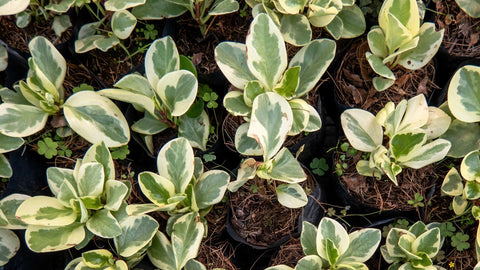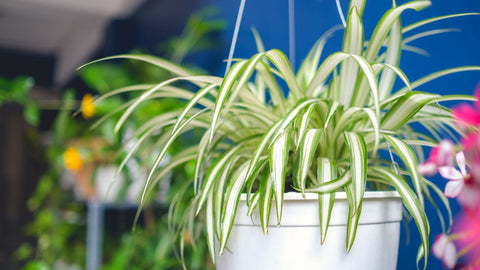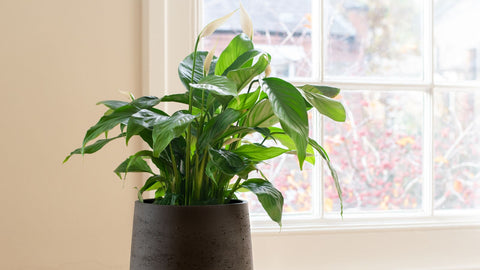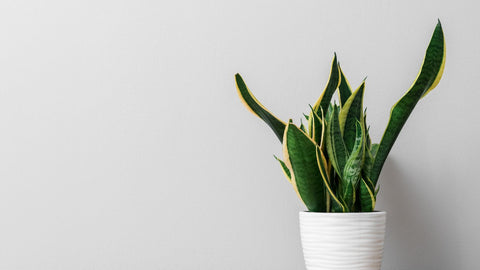5 Best Low Light Indoor Plants: Complete Care Guide (2024)
•Posted on December 29 2023

5 Best Low Light Indoor Plants: Complete Care Guide (2024)
What You'll Learn
Looking for indoor plants that thrive in shade? Not all areas of your home get direct sunlight, making low-light tolerant plants essential, especially during long winter months. These resilient plants not only survive in minimal light conditions but also purify your indoor air and add natural beauty to any room.
In this comprehensive guide, we'll explore five low-maintenance indoor plants perfect for spaces with limited natural light. You'll learn exactly how to care for each plant, including watering schedules, fertilizer needs, and placement recommendations.
1. Peperomia: The Perfect Low-Light Houseplant

Peperomia is a diverse genus from the Piperaceae family, with over 1000 species thriving in tropical and subtropical regions. These compact beauties are ideal for indoor spaces with minimal light requirements.
Peperomia Benefits and Key Features:
- Ideal for low light conditions
- Compact growth habit
- Low maintenance requirements
- Diverse plant family
Growth and Care:
- Water: Allow top soil to dry between waterings
- Light: Thrives in indirect light
- Humidity: Average room humidity is fine
- Temperature: Comfortable in normal room temperatures (60-75°F)
- Fertilizer: Apply a mixture of Organic Blood Meal, Organic Kelp Meal, Organic Fish Bone Meal, and Organic Azomite for optimal results. (See table below)
2. Spider Plant: Nature's Air Purifier

The Spider Plant (Chlorophytum comosum) is renowned for its adaptability and air-purifying abilities. With a lifespan of 20-50 years, this pet-friendly plant offers exceptional value for indoor gardeners.
Spider Plant Benefits and Key Features:
- Natural air purification capabilities
- Safe for pets and children
- Produces plantlets for easy propagation
- Thrives with minimal attention
Growth and Care:
- Water: Keep soil lightly moist, not soggy
- Light: Thrives in indirect light, tolerates low light conditions
- Humidity: Average room humidity is fine
- Temperature: Comfortable in normal room temperatures (60-75°F)
- Fertilizer: Apply a mixture of Organic Blood Meal, Organic Kelp Meal, Organic Fish Bone Meal, and Organic Azomite for optimal results. (See table below)
Expert Tip: Spider plants produce more plantlets when slightly root-bound. Wait to repot until roots are visibly crowded.
3. Golden Pothos: The Indestructible Vine

Golden Pothos (Epipremnum aureum), also known as Devil's Ivy, is prized for its remarkable ability to filter indoor air toxins and survive in almost complete darkness. This versatile vine adds a tropical touch to any indoor space.
Safety Note: While beautiful, Golden Pothos is toxic to pets and humans if ingested. Keep out of reach of children and animals.
Golden Pothos Benefits and Key Features:
- Excellent air-purifying capabilities
- Survives in very low light conditions
- Removes formaldehyde from indoor air
- Adapts to various growing conditions
Growth and Care:
- Water: Allow top 1-2 inches of soil to dry between waterings
- Light: Adaptable to low light, but variegation is best in moderate indirect light
- Humidity: Tolerates average indoor humidity
- Temperature: Comfortable in normal room temperatures (60-75°F)
- Growth Pattern: Can trail or climb, depending on support
- Fertilizer: Apply a mixture of Organic Blood Meal, Organic Kelp Meal, Organic Fish Bone Meal, and Organic Azomite for optimal results. (See table below)
4. Peace Lily: Elegant Air Purifier

The Peace Lily (Spathiphyllum) combines elegant white blooms with powerful air-purifying abilities. This sophisticated plant thrives in low light and adds a touch of class to any interior.
Peace Lily Benefits and Key Features:
- Produces white flowers even in low light
- Excellent air purification capabilities
- Dramatic foliage with glossy leaves
- Natural humidity indicator
Growth and Care:
- Water: Keep soil consistently moist but not waterlogged
- Light: Thrives in low to moderate indirect light
- Humidity: Tolerates average indoor humidity
- Temperature: Comfortable in normal room temperatures (60-75°F)
- Fertilizer: Apply a mixture of Organic Blood Meal, Organic Kelp Meal, Organic Fish Bone Meal, and Organic Azomite for optimal results. (See table below)
5. Snake Plant: The Ultimate Low-Light Survivor

Snake Plant (Sansevieria trifasciata), also known as Mother-in-Law's Tongue, is legendary for its ability to thrive in almost any condition. This architectural plant is perfect for beginners and experts alike.
Snake Plants Benefits and Key Features:
- Extremely drought tolerant
- Excellent air purifier, especially at night
- Striking vertical growth pattern
- Nearly indestructible nature
Growth and Care:
- Water: Allow soil to dry completely between waterings
- Light: Adapts to any light level, from low to bright indirect
- Humidity: Tolerates average indoor humidity
- Temperature: Comfortable in normal room temperatures (60-75°F)
- Fertilizer: Apply a mixture of Organic Blood Meal, Organic Kelp Meal, Organic Fish Bone Meal, and Organic Azomite for optimal results. (See table below)
Expert Tip: Snake plants can go weeks without water and still thrive. When in doubt, it's better to underwater than overwater.
Essential Care Tips for Low-Light Indoor Plants
General Maintenance Guidelines:
- Rotate plants quarterly to ensure even growth
- Dust leaves monthly to maximize light absorption
- Check soil moisture weekly
- Monitor for signs of pest infestation
- Maintain stable room temperature (65-75°F)
Common Problems and Solutions:
| Issue | Affected Plants | Possible Causes | Solutions | Prevention Tips |
|---|---|---|---|---|
| Yellow Leaves | All Plants |
|
|
Use well-draining soil and pots with drainage holes |
| Brown Leaf Tips | Peace Lily, Spider Plant |
|
|
Maintain humidity above 40%, use room temperature water |
| Leggy Growth | Pothos, Peperomia |
|
|
Rotate plants regularly, prune consistently |
| Wilting | All Plants |
|
|
Establish consistent watering routine, avoid temperature extremes |
| Pest Infestation | All Plants |
|
|
Regular inspection, maintain good air circulation |
Fertilizer Guide for Low-Light Plants
Proper fertilization is crucial for low-light plants, as they need additional nutrients to thrive in less-than-ideal light conditions. Here's our comprehensive guide to fertilizing each plant type effectively.
Specific Fertilizer Recommendations
| Fertilizer Type | 4-6" Pot | 8-10" Pot | Application Timing |
|---|---|---|---|
| Blood Meal | 1/2 teaspoon | 1 teaspoon | Early Summer (apply with Kelp) |
| Kelp Meal | 1 tablespoon | 2 tablespoons | • Early Spring (with Fish Bone Meal) • Late Spring (with Fish Bone Meal) • Early Summer (with Blood Meal) |
| Fish Bone Meal | 2 teaspoons | 2 tablespoons | • Early Spring (with Kelp) • Late Spring (with Kelp) • Late Summer • Early Fall |
| Azomite | 1 tablespoon | 2 tablespoons | Spring and Summer |
Seasonal Fertilizing Tips
- Spring/Summer: Fertilize regularly according to schedule - plants are in active growth
- Fall: Reduce fertilization by half as growth slows
- Winter: Minimal to no fertilization needed during dormancy
Application Guidelines
- Always water plants thoroughly before applying any fertilizer
- For plants in very low light, use 25% less than the recommended amount
- Spread fertilizer evenly around the base of the plant, avoiding direct contact with stems
- Water lightly after application to help nutrients reach the roots
Frequently Asked Questions
Most low light indoor plants need watering every 1-2 weeks. Always check the top inch of soil - if it's dry, it's time to water. The exact frequency depends on:
- Room humidity levels
- Season (less frequent in winter)
- Pot size and material
- Type of soil mix used
Yes, low light plants need fertilizer but usually require less than plants in bright light. Feed monthly during the growing season (spring and summer) with a balanced, water-soluble fertilizer at half strength.
Watch for these signs of insufficient light:
- Leggy or stretched growth
- Smaller new leaves
- Slower growth rate
- Loss of variegation
- Leaves turning yellow or pale
While most low light plants can survive with minimal natural light, they still need some light to thrive. In spaces with no natural light, consider:
- Using LED grow lights
- Rotating plants to brighter spots periodically
- Choosing extremely tolerant species like Snake Plants or ZZ Plants
Prevent pest problems in low light plants by:
- Maintaining good air circulation
- Avoiding overwatering
- Regular inspection of leaves and stems
- Wiping leaves with neem oil monthly
- Quarantining new plants before introducing them
Comments
0 Comments
Leave a Comment